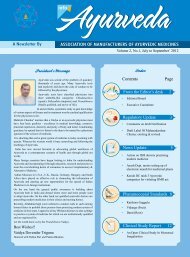Volume 2, No.5, July to September' 2013 - amam-ayurveda.org
Volume 2, No.5, July to September' 2013 - amam-ayurveda.org
Volume 2, No.5, July to September' 2013 - amam-ayurveda.org
Create successful ePaper yourself
Turn your PDF publications into a flip-book with our unique Google optimized e-Paper software.
• Marketed Preparations/Formulations 14<br />
Preparations/Formulations made of Ashwagandha are being marketed in<br />
India by various companies in various indications like anti-depressant,<br />
anxiolytic, general health <strong>to</strong>nic, memory booster, central nervous system<br />
stimulant, sedative and tranquilizer, immunomodula<strong>to</strong>r etc under different<br />
brand names since many years. There is no specific safely concerns yet<br />
reported/documented on the formulations.<br />
V. Pharmacological Studies on Ashwagandha<br />
Scientifically, Withania somnifera has been widely studied for its beneficial<br />
effects. The extracts have been tested in various pharmacological<br />
parameters. A study has shown that Withania somnifera extract<br />
significantly reduced the fibro-sarcoma onset as well as incidence at the<br />
end of therapy. There was a significant reduction in the tumor volume with<br />
Withania somnifera extract treated mice as compared <strong>to</strong> the control and<br />
it significantly increased the survival rate. 15 In another study the markers<br />
of chronic stress, namely, augmented gastric ulceration, and perturbed<br />
adrenocortical activity were attenuated by Withania somnifera which<br />
indicated that Withania somnifera has significant adap<strong>to</strong>genic activity. 16<br />
Withania somnifera tend <strong>to</strong> normalize the stress-induced neurochemical<br />
perturbations. It has shown <strong>to</strong> be effective in attenuation chronic stress<br />
induced physiological and behavioral disturbances, was also effective<br />
in tending <strong>to</strong> normalize chronic stress induced neurochemical changes. 17<br />
Withania somnifera exerts cardioprotective effect in the experimental<br />
model of isoprenaline-induced myonecrosis in rats. Augmentation of<br />
endogenous antioxidants, maintenance of the myocardial antioxidant<br />
status and significant res<strong>to</strong>ration of most of the altered haemodynamic<br />
parameters may contribute <strong>to</strong> its cardioprotective effect. 18 The root<br />
powder of Withania somnifera with the presence of natural antioxidants,<br />
bioflavanoids, and other bioactive compounds scavenged the free radicals<br />
generated by gentamycin and ameliorated the severity of gentamycininduced<br />
nephro<strong>to</strong>xicity by enhancing the antioxidant system and protecting<br />
the cellular integrity of kidney and liver tissues. 19 Administration of an<br />
extract from the powdered root of the plant Withania somnifera was found<br />
<strong>to</strong> stimulate immunological activity in mice. Treatment with doses of<br />
Withania root extract was found <strong>to</strong> enhance the <strong>to</strong>tal WBC count. Bone<br />
marrow cellularity as well as α-esterase positive cell number also increased<br />
significantly after the administration of Withania extract. Treatment with<br />
Withania extract along with the antigen produced an enhancement in the<br />
circulating antibody titre and the number of plaque forming cells in the<br />
spleen. Withania extract inhibited delayed type hypersentivity reaction in<br />
mice and have shown an enhancement in phagocytic activity of peri<strong>to</strong>neal<br />
macrophages when compared <strong>to</strong> control. 20<br />
4. POSOLOGY<br />
• In Powder Form (Ashwagandha Churna): 3-6 g in powder form 2<br />
• Ashwagandha Ghrita: 2-3 drops in children 21<br />
• Kwath (Decoction): 90-100 ml in Adults 22<br />
5. SUMMARY AND CONCLUSION<br />
The present review was compiled <strong>to</strong> establish the safety aspect of<br />
Ashwagandha (Withania somnifera) through the background of its<br />
his<strong>to</strong>ry, usage (folklore, Ayurvedic literature, concurrent use), efficacy<br />
info Ayurveda, <strong>Volume</strong> 2, <strong>No.5</strong>, <strong>July</strong> - Sept’ <strong>2013</strong><br />
and quality standards in view of the Indian context. Various published<br />
litratures, review articles, pharmacopoeias, formularies are being refered<br />
<strong>to</strong> compile this brief on Ashwagandha. There are many formulations in<br />
which Ashwagandha is used however, in this review we have refered few<br />
among them.<br />
Ashwagandha finds its reference as a time tested age old herb and is<br />
described in various Ayurvedic literature for its actions and therapeutic<br />
uses and has been used since the era dating back <strong>to</strong> 1000 B.C. safely <strong>to</strong> cure<br />
human diseases. Ayurvedic literature and published books are available<br />
documenting its properties and uses either as prescribed medicine or as<br />
folk / traditional medicine both in external and internal route. Its properties<br />
and therapeutic uses are also described in the scheduled Ayurvedic books<br />
of Government of India.<br />
Ashwagandha (Withania somnifera) has been tested in various quality<br />
parameters for standardization in different pharmacopoeias and<br />
fingerprinting (TLC & HPLC) techniques. In the reviewed Pharmacopoeias<br />
i.e the Ayurvedic Pharmacopoeia of India and Indian Pharmacopoeia, the<br />
standardization techniques have been described and complete assay along<br />
with other parameters are mentioned.<br />
Scientific studies and the his<strong>to</strong>rical references in the Ayurvedic literatures,<br />
concurrent usage, popularity of the plant, his<strong>to</strong>rical safe usage both as<br />
medicine and health promoter agent, establishes its safety and efficacy.<br />
6. REFERENCES<br />
1. Withania somnifera – The Indian Ginseng Ashwagandha by Sandhya Singh and Sushil<br />
Kumar published by Central Institute of Medicinal and Aromatic Plants (CIMAP),<br />
Lucknow, India.<br />
2. Database on medicinal plants used in Ayurveda, Vol 3, pp 88-93, Published by Central<br />
Council for Research in Ayurveda and Siddha, New Delhi.<br />
3. The Ayurvedic Pharmacopoeia of India, Part 1, <strong>Volume</strong> – 1, Government of India,<br />
Ministry of Health and Family Welfare, Department of Indian System of Medicine and<br />
Homoeopathy, New Delhi.<br />
4. Indian Pharmacopoeia of India, 2007<br />
5. Charak Samhita, Sutrasthana, Chapter IV and Vimanasthanam, Chapter VIII, Sloka 139,<br />
Chikitsa Sthanam Published by Chaukhamba Orientalia.<br />
6. Bhavprakash Nighantu by Sri brahmasankara Misra and Ruplalji Vaisya published by<br />
Chaukhamba Sanskrit Sansthan, Page 393 -394.<br />
7. Kaiyadeva Nighantu by Prof. Priyavrata Sharma & Dr Guru Prasad Sharma, Published by<br />
Chaukhamba Orientalia, Varanasi, Sloka 1044-1046<br />
8. Madanpal Nighantu by Khemraj Srikrishna Das Prakashan, Mumbai, Sloka 73-74<br />
9. Bharat Bhaishajya Ratnakar, Translated by Gopinath gupta –Vol III –B, Jain Publishers,<br />
New Delhi, Edn. 2 nd , Reprint Aug 1999, PP-36.<br />
10. Bharat Bhaishajya Ratnakar, Translated by Gopinath gupta –Vol IV –B, Jain Publishers,<br />
New Delhi, Edn. 2 nd , Reprint Aug 1999, PP-32.<br />
11. Bharat Bhaishajya Ratnakar, Translated by Gopinath gupta –Vol IV –B, Jain Publishers,<br />
New Delhi, Edn. 2 nd , Reprint Aug 1999, PP-119.<br />
12. Bharat Bhaishajya Ratnakar, Translated by Gopinath gupta –Vol III –B, Jain Publishers,<br />
New Delhi, Edn. 2nd, Reprint Aug 1999, PP-634.<br />
13. The Ayurvedic Formulary of India Part I and II: Published by Government of India,<br />
Ministry of Health and Family welfare, Department of Indian Systems of Medicine &<br />
Homoeopathy, New Delhi<br />
14. Ayurvedline – Ayurvedic Drug Index.<br />
15. Anti-tumor and Anti-oxidant activity of Withania somnifera in Swiss albino mice<br />
conducted by Dr S K Gupta, All India Institute of Medical Sciences, Ansari Nagar, New<br />
Delhi.<br />
16. Adap<strong>to</strong>genic properties of Aswagandha (Withania somnifera) by Prof S K Bhattacharya,<br />
Varanasi and Prof. D. Bhattacharya, Calcutta<br />
17. Neurochemical studies on Withania somnifera conducted by Dr S K Bhattacharya,<br />
Department of Pharmacology, Institute of Medical Sciences, Banaras Hindu University,<br />
Varanasi.<br />
18. Basic Clin Pharmacol Toxicol. 2004 Apr;94(4):184-90; Mechanisms of cardioprotective<br />
effect of Withania somnifera in experimentally induced myocardial infarction; Mohanty I,<br />
Arya DS, Dinda A, Talwar KK, Joshi S, Gupta SK<br />
19. J Basic Clin Physiol Pharmacol. 2010;21(1):61-78; Protective effect of Withania<br />
somnifera root powder on lipid peroxidation and antioxidant status in gentamicin-induced<br />
nephro<strong>to</strong>xic rats; Jeyanthi T, Subramanian P<br />
20. J. Ethnophamacology 71 (200) 193-200; Immunomodula<strong>to</strong>ry activity of Withania<br />
somnifera; L. Davis & G. Kut<strong>to</strong>n<br />
21. Ashwagandha Ghrita, Bhaisajya Ratnavali, Balrogadhikara, P-735<br />
22. Sharangdhara Samhita, Edition PHC Murry, Chaukhamba Publisher 2001, P- 111<br />
12


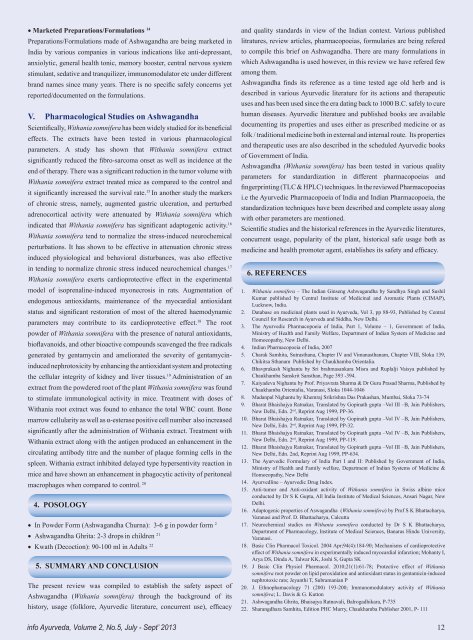

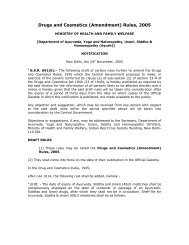
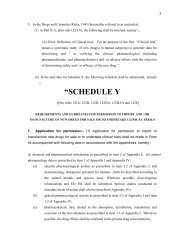
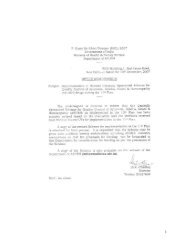

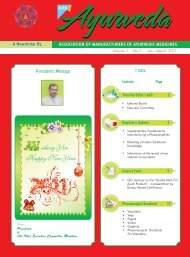

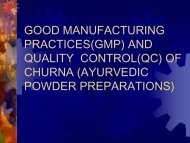
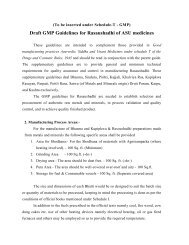
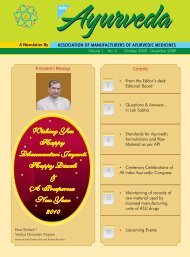
![[To be published in Gazette of India Part II Section 3, sub-section iii]](https://img.yumpu.com/28570283/1/190x245/to-be-published-in-gazette-of-india-part-ii-section-3-sub-section-iii.jpg?quality=85)

